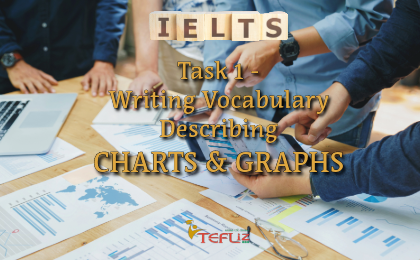IELTS Writing Vocabulary for Describing Charts and Graphs Task 1
In this blog post, we will cover the IELTS writing vocabulary for describing charts and graphs for Task 1 in the IELTS Academic exam, providing you with essential terms and phrases that will help you present data clearly, concisely, and effectively.
By mastering this specialized vocabulary, you’ll be well-equipped to analyze and articulate the key trends and comparisons in various types of data presentations, a crucial skill for achieving a high score in this section of the exam. If you want more topic-based language for the exam, see my full IELTS vocabulary guide.
1. Understanding the Types of Visual Information
Before you begin, it’s crucial to identify what kind of graph or chart you are dealing with. Is it a line graph, bar chart, pie chart, or maybe a table? Each type has its unique features and, thus, requires specific vocabulary. For instance, a line graph typically shows changes over time, so you’ll use time-related words. On the other hand, a pie chart gives you a percentage breakdown, which means you’ll focus more on proportions.
2. Describing Trends:
One of the key tasks in IELTS Academic Writing Task 1 is to describe trends. Here are some useful terms:
- Increase / Rise / Grow: When numbers go up. Example: “There was a significant rise in the sales of electric cars.”
- Decrease / Fall / Drop: When figures go down. Example: “The population of bees saw a dramatic decrease over the decade.”
- Remain Stable / Level Off: When there’s little or no change. Example: “The unemployment rate remained stable throughout the year.”
- Fluctuate: When data shows irregular changes. Example: “The stock market prices fluctuated considerably last month.”
3. Describing Amounts and Proportions:
When you’re dealing with numbers, it’s essential to describe them accurately.
- Majority / Minority: Useful for pie charts and when referring to the larger or smaller segments. Example: “A majority of the participants preferred online courses.”
- Fraction / Portion: When you want to describe parts of a whole. Example: “A significant fraction of the budget was allocated to healthcare.”
- Considerable / Significant / Slight: These adjectives help show a change’s importance or size. Example: “There was a slight increase in the cost of living last year.”
4. Making Comparisons:
Often, you’ll need to compare data points.
- Higher than / Lower than: Basic comparison terms. Example: “The sales in 2020 were higher than in 2019.”
- Surpass / Lag Behind: To describe overtaking or falling behind in trends. Example: “Renewable energy usage has surpassed traditional coal-based energy.”
- Comparable / Similar to: When two data points are close in value. Example: “The GDP of Country X is comparable to that of Country Y.”
5. Describing Rate of Change:
Sometimes, the speed of change is as important as the change itself.
- Rapid / Quick / Swift: For fast changes. Example: “There was a rapid decline in printed newspaper sales.”
- Gradual / Steady / Slow: For more measured changes. Example: “There was a steady growth in the number of online subscribers.”
6. Connecting Your Ideas:
To make your description coherent and fluid, use linking words and phrases like:
- Furthermore / Moreover: To add more information.
- However / Nevertheless: To introduce a contrasting idea.
- Consequently / As a result: To show cause and effect.
Mastering IELTS Writing Vocabulary for Task 1
Mastering the vocabulary for describing charts and graphs is a significant step in excelling at the IELTS Academic Writing Task 1. Practice is key, so try applying these terms while analyzing different charts and graphs. Over time, you’ll find that these words come to you more naturally, enhancing your ability to communicate complex information clearly and effectively. Keep practising, and you’ll surely ace this part of the IELTS exam!

